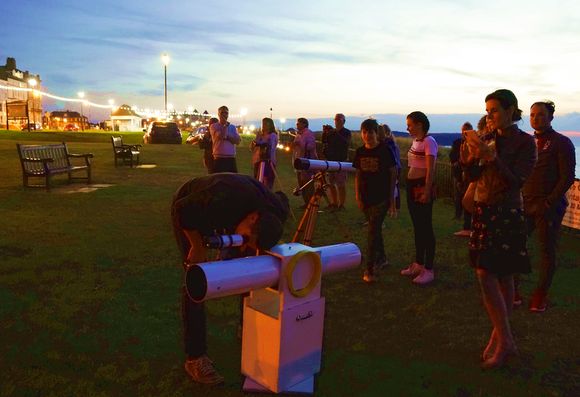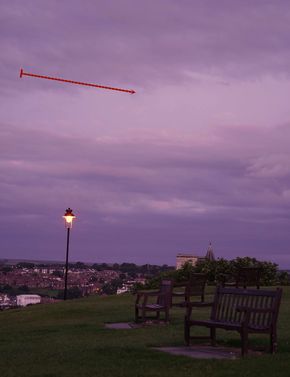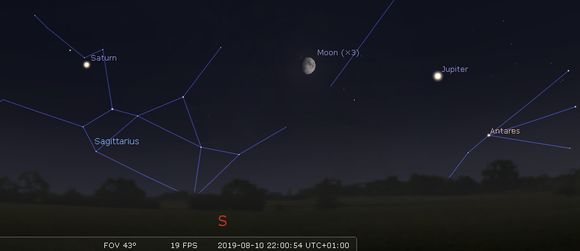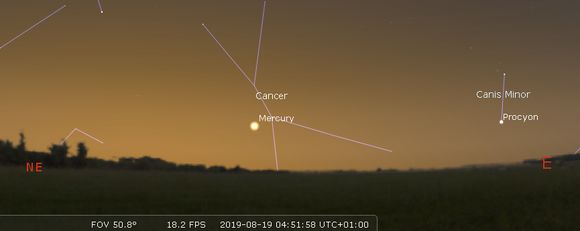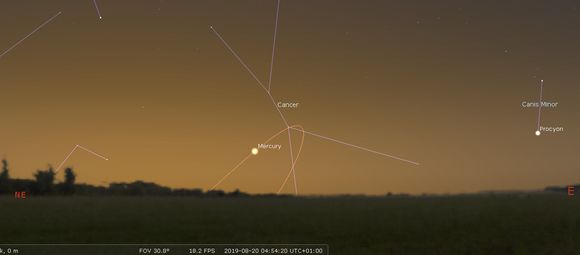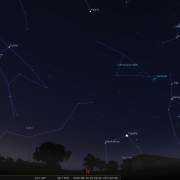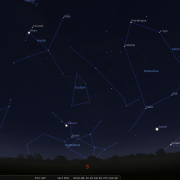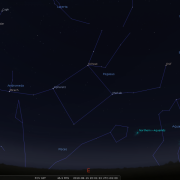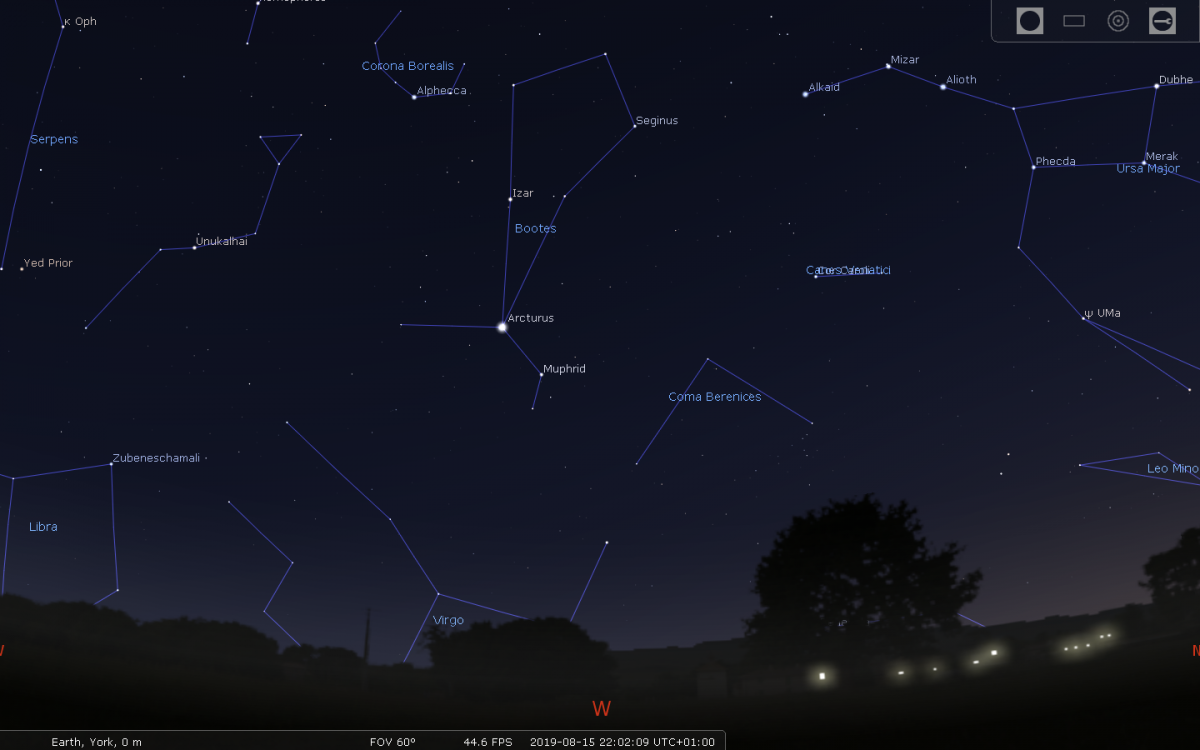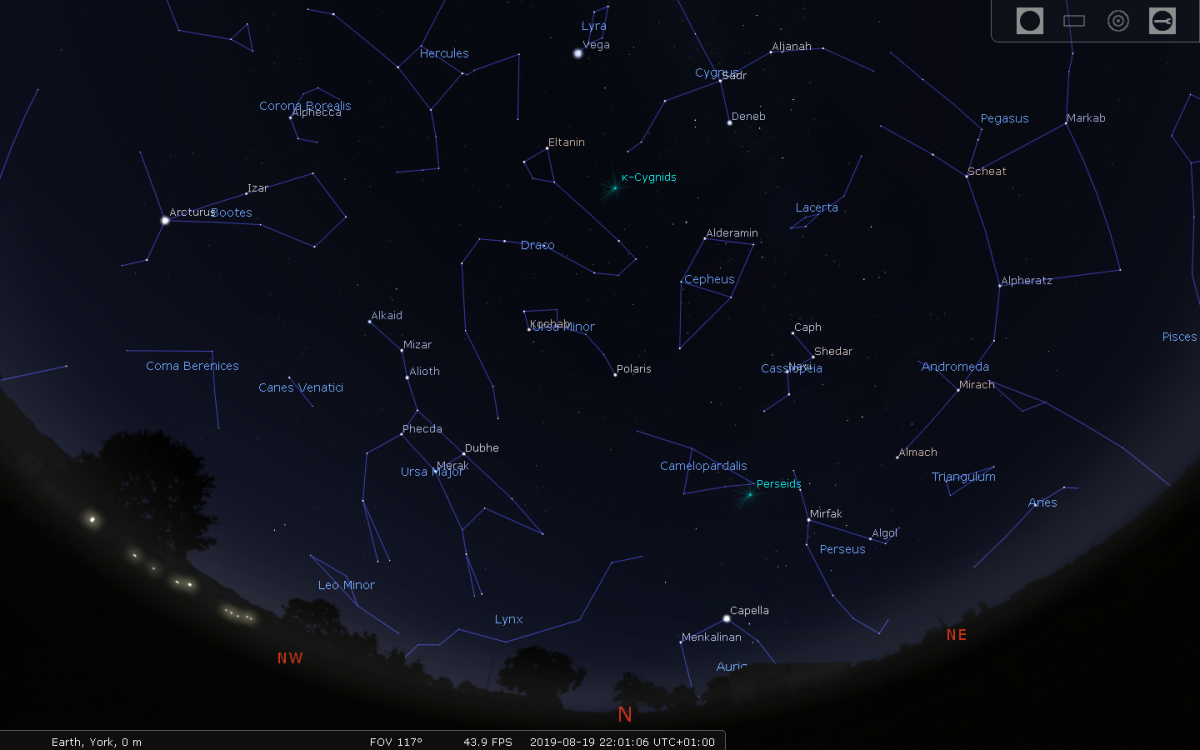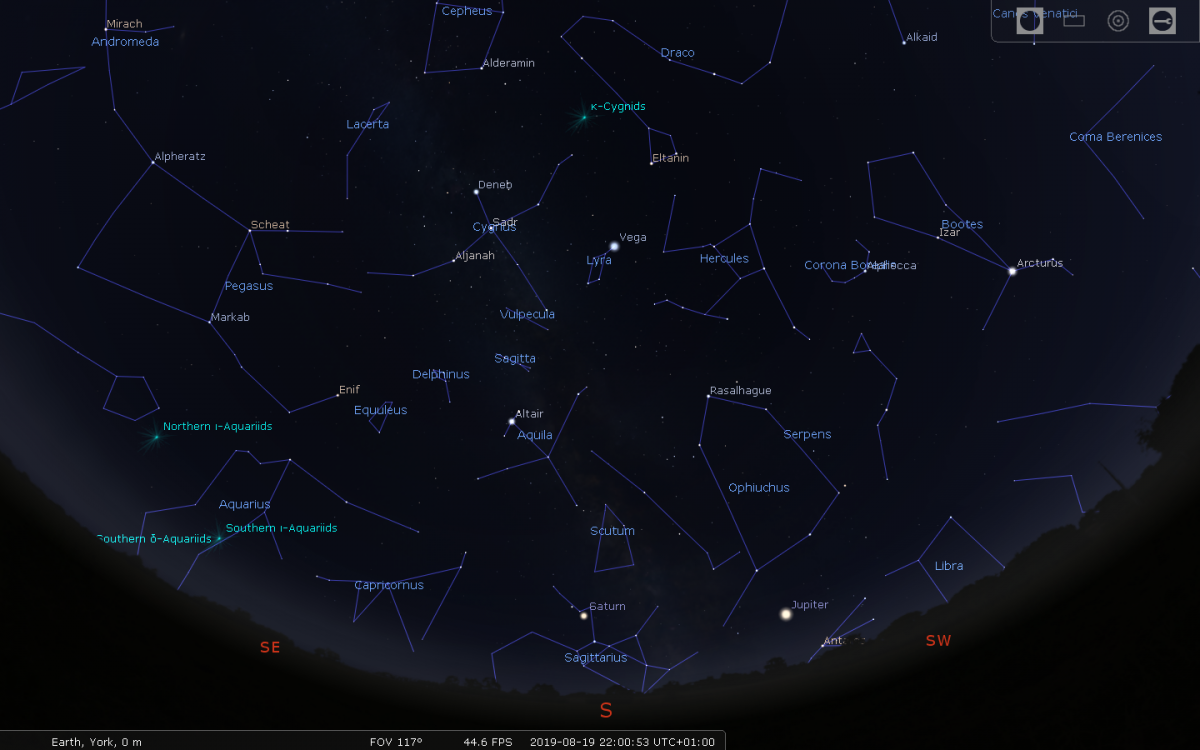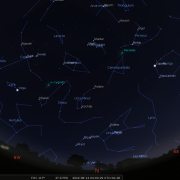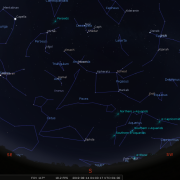Welcome to the WDAS monthly newsletter for August 2019: a digest of the month's latest contributions to our website. Below you'll find Society News; news aplenty past and coming events; a retirement; and, of course, your monthly Sky Notes.
Society News
Think back to July 2018, when during a long heat wave with the majority of evening’s fine, it was greatly frustrating to have apocalyptic weather for the total lunar eclipse on July 27th 2018.
Almost a year on (July 16th 2019) another lunar eclipse would grace our skies and again would already be underway as the moon rose. Not a total, but a partial eclipse. This time however prospects looked encouraging with clear skies forecast. Society members descended on the usual location – Cook’s headland well in time to set up the equipment, eventually deploying six scopes.
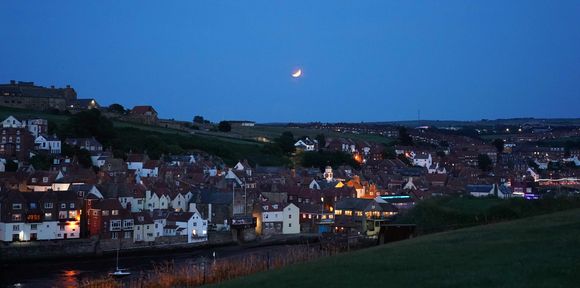
You got the feeling that it would be one of those evenings where public interest would be considerable, especially with conditions conducive for people to stay and by 21:30h many of the nearby seats were occupied.
Around 21:40h Jupiter was picked up in the twilight sky, becoming our first target. People queued eagerly to view our largest planet.
It wasn’t until 21:50h we had our first glimpse of the Moon. The initial stages of the eclipse, first and second contacts, had already occurred, before local moon rise, so it was already immersed in Earth’s umbral (deeper) shadow as it climbed over the SSE horizon. Resembling a reddish/orange quarter moon in appearance, anyone who wasn’t aware it was supposed to be a full moon would have assumed it was just that!
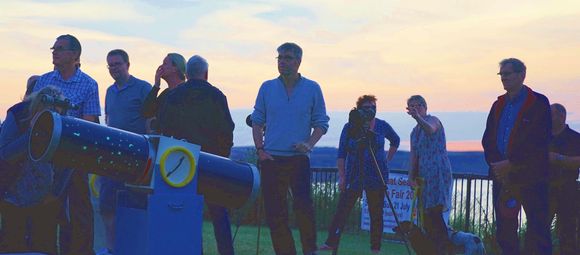
Mid eclipse occurred around 22:30pm, by which time approximately 56% of the moon was in umbral shadow. Shortly before this however we had our first fleeting glimpses of Saturn, playing hide and seek in the wispy broken cloud in that part of the sky low to the SE. People were bowled over see the ring system, even though the image was not at its best due to the low altitude. By 23:00h people began thinning out, so we as it was a week day we began packing up.
The moon would reach 4th contact around midnight, finally moving out of Earth’s Umbral shadow, with the penumbral phase ending shortly before 01:22h.
It had been an excellent evening, much enjoyed by all present. Unloading at Mark’s house, there was one final surprise when the ISS was spotted crossing over, becoming more brilliant than Jupiter, rounding off the night in style. Thanks to Elaine and Phil, Keith and John and especially Barbara and Mark for their assistance with equipment, loading and unloading.
___
Photos by Keith. Click here to see more pictures in the Gallery.
 No, not from the society, but from work (lucky so-and-so) Keith has worked for the last 41 years as a science technician at what was Whitby School, then Whitby College and finally Caedmon College. Most of us still refer to it as the former.
No, not from the society, but from work (lucky so-and-so) Keith has worked for the last 41 years as a science technician at what was Whitby School, then Whitby College and finally Caedmon College. Most of us still refer to it as the former.
You can almost say Keith has worked there ‘man and boy’. Starting in 1978 he has witnessed many changes not only in technology, but also teachers. Mark remembers Keith back in 1979-81, when he would be bustling in and out of science labs, tinkering and coaxing many an item of equipment back into action, extending even to the School computer (remember those days when IT consisted of just that –one computer) I’m sure one or two more society members will also remember Keith from back whenever they were there.
After 41 years or servitude, we all wish Keith a long and happy retirement, pursuing his hobbies and interests, which of course include his involvement with the society. See you soon Keith - weather permitting!
We finally manage to host a scheduled star party on July 6th. Conditions were not, shall we say ‘summery’ but at least there was enough clear sky to view the crescent Moon and fortuitously, Jupiter, in a slender gap.
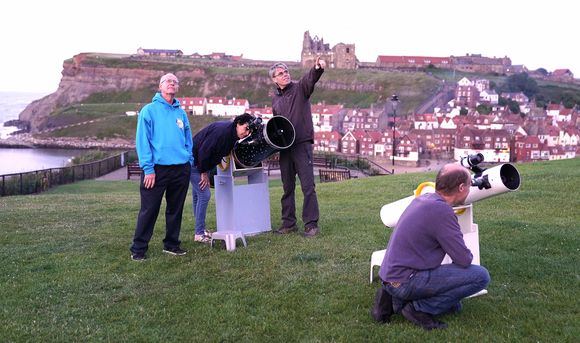
It has to be said public were a little scarce on the ground, but those who did venture over were impressed with the lunar views, and really wowed by Jupiter and attendant Galilean moons.
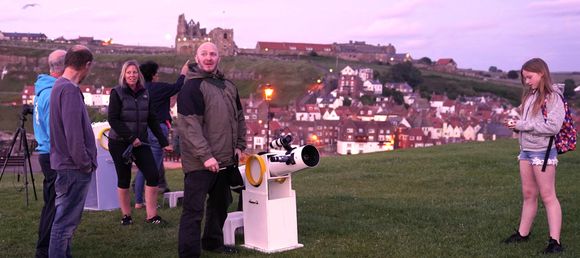
At the very least the event served as the backdrop for a Sky at Night on-line article Mark had been asked to write. Just a pity the lunar eclipse event was after the deadline.
A really fine display of Noctilucent cloud was observed by Mark and other society members, including Elaine and Phil during the late evening of July 11th 2019.
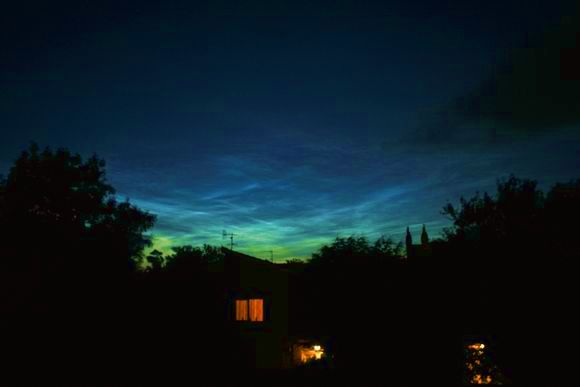
Mark first noticed something developing low to the north shortly after 23:10h. Observing from his back bedroom window –which faces north, Mark followed the display until almost midnight, taking some images in the process. Visible only at this time of year, Noctilucent cloud forms almost exclusively between latitudes 50 and 60 degrees north, at altitudes in excess of 50 miles.
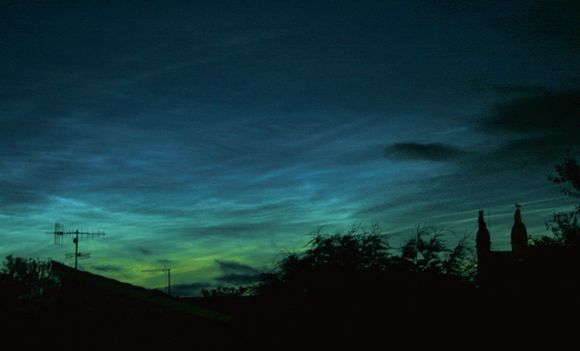
In appearance the cloud is filamentary in structure, having a characteristic silvery-blue colour. It forms when water vapour condenses at very low temperatures onto particles suspended in the air, perhaps pollutants. Do keep an eye out during the early part of August for any further displays, you just never know.
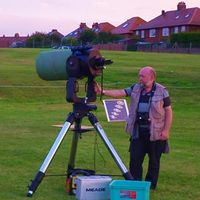 This year’s Regatta events will be similar in setup to previous ones with afternoon solar viewing, on Saturday (10th) and Sunday (11th), followed by evening star parties on both dates.
This year’s Regatta events will be similar in setup to previous ones with afternoon solar viewing, on Saturday (10th) and Sunday (11th), followed by evening star parties on both dates.
The location of the solar viewing event will be the grassy area adjacent to the small Go-carts track on the West Cliff and in proximity to the Grovers Optics stand. We shall be setting up from 13:00h for a 13:30h start, finishing around 16:15h.
The evening star parties will be held on the pitch and put area, above the archery green, as per last year. Parking is adjacent to this area - down the side of pitch and put, accessed over the parking area behind the bowling green. It is actually quite convenient. We shall be setting up from 20:30h. If conditions are fine and you can make it along, assistance would be most welcome.
As for the rest of August – we have Folk week and the bank holiday events to look forward to. August dates seem to be very susceptible to the weather, so I have put quite a few dates down. Expect half to be called off. Again if it is a fine night on a scheduled date and you can make it please do come along.
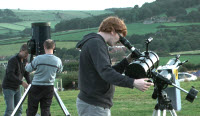 Our annual visit to Hook’s House Fm will be slightly earlier this year – Saturday 31st August 2019.
Our annual visit to Hook’s House Fm will be slightly earlier this year – Saturday 31st August 2019.
It will be a no-Moon period and if skies are clear it should be ideal for deep sky observations. We shall of course be observing both Jupiter and Saturn on show to the south and carrying out a sky tour. We anticipate the campsite will be busy, so if you make along with a scope all the better. We hope to be setting up equipment for shortly after 20:00h with a view to a 20:30h start.
If you already have a scope and know the location of Hook’s House Campsite (just off the B1447 down in to Robin Hood’s Bay) we shall see you there. If you have transport but no equipment, meet at Mark’s for 19:45h. If conditions are favourable it should be an excellent evening.
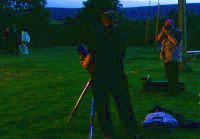 Our annual jaunt over to Westerdale will on the other hand be a little later this year. THe 27th September 2019 is the date for your diary, from 19:00–22:00h. More on this next month.
Our annual jaunt over to Westerdale will on the other hand be a little later this year. THe 27th September 2019 is the date for your diary, from 19:00–22:00h. More on this next month.
Sky Notes
In this month's Sky Notes:
Planetary Skylights
Three naked eye planets dominate this month; Jupiter and Saturn in the late evening sky, and Mercury in the dawn sky.

Jupiter is visible as soon as skies become dark enough and at Magnitude -2.5 is the brightest point in the night sky. Look for it across in the SSW as dusk falls not too far above the horizon residing in the southern most reaches of Ophiuchus. Have patience at the eyepiece when observing, waiting for those moments of steady seeing.
Look for the belts across the disk and when turned in our direction the great red spot, residing on the south equatorial belt. Consensus of data and observations do show that the GRS has shrunk by well over a third in the last decade and is being closely watched by astronomers to see whether this will continue. In the eyepiece it resembles a pale oval.
The most dynamic aspect of the Jovian system, the four Galilean moons, certainly warrants attention, with an ever changing configuration noticeable even over the course of a few hours.
On August 27th Jupiter again has a very close encounter with the deep sky object NGC 6235, a magnitude 9 globular cluster some 37,000 light-years distant.
Galilean moon shadow transits
- Io, 30/31st: ends at 21:06h
- Europa: 3/4th: 21:00–23:09h.
Great Red Spot visibility on Jupiter’s Disk
- 2/3rd: 23:30–01:17h
- 5/6th: 22:47–Central Meridian
- 7/8th: 22:30–00:25h
- 10/11th: 22:00h–Central Meridian
- 12/13th: 23:30h
- 17/18th: transits 22:43h
- 22/23rd: transits 21:52h
- 24/25th: transits 23:30h
- 27/28th: transits 21:00h
- 29/30th: transits 23:40h.
The Moon lies nearby Jupiter in the sky on the 9th.
 The Moon lies nearby Jupiter in the sky on the 9th.
The Moon lies nearby Jupiter in the sky on the 9th.
 Having reached opposition last month Saturn is actually better placed for observations at sensible hours during the comings months. Following Jupiter’s across the south by a few hours, Saturn will be on show low in the SE by 21:00h by the start of August arcing low across the south over the course of the night. Currently visible at Magnitude +0.1, Saturn is quite prominent to naked eye. Like Jupiter, observations of Saturn are somewhat compromised due to the low altitude, but patience at the eyepiece will be rewarded with the glorious rings evident in modest telescopes. The two main rings ring A and ring B, separated by the Cassini division are the most evident. Saturn’s largest moon; Titan, is visible as a speck of light nearby. Our moon lies in proximity to Saturn in the sky on the 11th/12th.
Having reached opposition last month Saturn is actually better placed for observations at sensible hours during the comings months. Following Jupiter’s across the south by a few hours, Saturn will be on show low in the SE by 21:00h by the start of August arcing low across the south over the course of the night. Currently visible at Magnitude +0.1, Saturn is quite prominent to naked eye. Like Jupiter, observations of Saturn are somewhat compromised due to the low altitude, but patience at the eyepiece will be rewarded with the glorious rings evident in modest telescopes. The two main rings ring A and ring B, separated by the Cassini division are the most evident. Saturn’s largest moon; Titan, is visible as a speck of light nearby. Our moon lies in proximity to Saturn in the sky on the 11th/12th.
 Elusive Mercury has a fine morning apparition lasting nearly all month. It will be easiest to spot between the 17th and 23rd approximately 10 degrees above the ENE horizon around 45 minutes before sunrise. For morning apparitions Mercury always appears brightest towards the end, the downside being it will then be very low. An unobstructed aspect is required, but given clear dawn skies Mercury should be evident to the naked eye. Perhaps use binoculars to help pick it out of the dawn twilight initially.
Elusive Mercury has a fine morning apparition lasting nearly all month. It will be easiest to spot between the 17th and 23rd approximately 10 degrees above the ENE horizon around 45 minutes before sunrise. For morning apparitions Mercury always appears brightest towards the end, the downside being it will then be very low. An unobstructed aspect is required, but given clear dawn skies Mercury should be evident to the naked eye. Perhaps use binoculars to help pick it out of the dawn twilight initially.
Meteors

August means shooting stars on the astronomical calendar with the annual Perseid meteor shower reaching a peak. The Perseids are one of the more reliable meteor showers, and given the time of year undoubtedly the most widely observed by the general public. Conditions this year however will not be ideal, with the moon just a few days off full, drowning out many of the fainter meteors.
Sometimes known as "The tears of St. Lawrence"; the martyred Christian deacon whose feast day falls on Aug 10th, just two days before the Perseids peak, these particular ‘tears’, like the majority of meteor showers, are composed of debris deposited over many thousands of years by periodic comets. Perseids are associated with comet Swift Tuttle which takes around 130 years to orbit the Sun. Perseid meteoroids are not dissimilar in size and density to that of instant coffee granules with the occasional pea or marble sized fragment. Each August, Earth encounters various strands of the Swift-Tuttle debris stream giving rise to the eagerly anticipated shooting stars.
Perseid meteoroids penetrate the upper atmosphere 60 miles above us at speeds of 43miles/second, interacting with atoms as they do so, before becoming ionised and releasing a packet of light. It is this brief luminous flash we call a meteor. Particularly bright examples often leave behind persistent ionisation trails in their wake, the classic shooting star. The radiant of the shower: the location in the sky from which the meteors appear to emanate, lies within the constellation of Perseus, which in August is rising in the north east during the evening. Perseid activity is highest from Aug 8th-15th reaching a peak this year over the night of Aug 12/13th.
Under ideal conditions the zenith hourly rate (ZHR) for the Perseids is typically 80-100, but moonlight will seriously restrict numbers this year to under 15 per hour, perhaps rising to 30 plus in the hour before dawn on the 13th.If observing view in areas of the sky a good hand span away from Perseus and around between 40-70 degrees above the horizon. Good luck.
August 2019 Sky Charts
|
Looking North
Mid-August - 22:00h |
Looking South |
|
Looking East
Mid-August - 22:00h |
Looking West
Mid-August - 22:00h |
|
Northern Aspect
Mid-August - 22:00h |
Southern Aspect
Mid-August - 22:00h |
| Looking North (Early) Mid-August - 04:00h |
Looking South (Early) Mid-August - 04:00h |
Additional Image Credits:
- Planets and Comets where not otherwise mentioned: NASA
- Sky Charts: Stellarium Software
Events
 Observe the night sky with us at the Bruce Observatory, Whitby School
Observe the night sky with us at the Bruce Observatory, Whitby School
Observing Nights are held weather permitting: check for a relatively clear sky before leaving home. If in doubt, Mark can be reached on 07886069339
Please note the college drive gate is now operated via a electronic key code - so anyone wishing to attend must be at the car park at the top of the drive by 19:00hrs - unless an arrival time has been arranged with Mark/Keith.
 Whitby School - Room H1.
Whitby School - Room H1.
In Members' monthly meetings we usually take a tour of the night sky for the coming month using the Planetarium program. Have talks and presentations on various topics of astronomy/space etc, and discuss future events etc. New members welcome.

